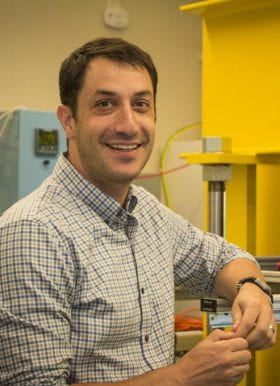
Philip Skemer
Associate Department Chair, Professor
- Phone: (314) 935-3584
- Email: pskemer@nospam.wustl.edu
CV
About me: I am originally from New Jersey, and have spent most of my life on the i95 corridor. I ventured west to attend Pomona College, originally to major in physics, then philosophy, then politics. I decided to become a geologist during my sophomore year when I came to the sudden realization that looking at rocks in places like Zzyzx California was a viable career option. I went to Yale for graduate school, where I developed a life-long interest in hydraulics, power tools, and electrical tape. I have been teaching at Washington University since 2009.
Research Interests
Fifty years ago, the wide-spread acceptance of plate tectonic theory spawned generations of scientists eager to understand plate motions and their influence over the geologic processes that affect life at Earth’s surface. Earth’s tectonic plates are characterized by interiors that may be stable over billions of years. However, the actively deforming boundaries between plates are subject to modification over much shorter time scales through the growth of mountains, the creation or recycling of lithosphere, and the transformation of landscapes by volcanic, seismogenic, and hydrologic processes. Earth’s particular style of plate tectonics appears to be unique in the solar system and undoubtedly contributes to some of the basic differences between the evolution of Earth and the other terrestrial planets. However, many fundamental questions about plate tectonics persist. What are the patterns of underlying mantle flow and what can we learn from these flow patterns about the convective forces that drive plate tectonics? What are the rheological properties of the rocks that make up the crust and mantle? How do plates form narrow, dynamic boundaries? How does plate tectonics begin in the first place?
I use geologic observations and experimental methods to study how rocks deform. My strategy is to use the micro- to meso-scale structures (~10-9-101m) of naturally deformed, highly sheared rocks from plate boundaries to assess the relative importance of specific deformation processes in Earth. I design rock deformation experiments to test the sensitivity of these processes to temperature, pressure, grain-size, chemical composition, and the magnitude of strain. Experimental data are then used to model how materials deform in parts of the Earth or other planetary interiors that are inaccessible to direct observation. I am particularly interested in the complex feedbacks between rheology and microstructure in the materials that make up the crust and mantle. Through my research, I seek to provide physically meaningful connections between geodynamic theory and models, seismological data, and direct geological observations.
Looking for PhD programs?
If you are interested in structural geology, rock mechanics, or geodynamics, and enjoy working with your hands, please send me an email. I would be happy to discuss my research program and graduate education at Washington University.
Recent Publications
- Billings K., Skemer P. (2024) Evolving microstructure during experimental deformation of Maryland diabase. Earth and Planetary Science Letters, https://doi.org/10.1016/j.epsl.2023.118564
- Sly M.K., Padilla K., Flores K.M., Skemer P. (2023) Low-temperature plastic rheology of granitic feldspar and quartz. Tectonophysics, https://doi.org/10.1016/j.tecto.2023.229850
- Horn C.M., Skemer P. (2023) Semi-brittle deformation of talc at the base of the seismogenic zone. Geophysical Research Letters, https://doi. org/10.1029/2022GL102385
- Bercovici D., Mulyukova E., Girard J., Skemer P. (2022) A coupled model for phase mixing, grain damage and shear localization in the lithosphere: Comparison to lab experiments. Geophysical Journal International, https://doi.org/10.1093/gii/ggac428
- Strozewski B., Sly M.K., Flores K.M., Skemer P. (2021) Viscoplastic rheology of a-quartz investigated by nano indentation. Journal of Geophysical Research: Solid Earth, https://doi. org/10.1029/2021JB022229
- Cross A.J, Olree E., Couvy H., Skemer P. (2020) How does viscosity contrast influence phase mixing and strain localization. Journal of Geophysical Research: Solid Earth, 125, https://doi.org/ 10.1029/2020JB020323
- Kranjc K., Thind A.S., Borisevich A.Y., Mishra R., Flores K.M., Skemer P. (2020) Amorphization and plasticity of olivine during low-temperature micropillar deformation experiments. Journal of Geophysical Research: Solid Earth, 125 (5), https://doi.org/10.1029/2019JB019242
- Horn C., Bouilhol P., Skemer P. (2020) Serpentinization, deformation, and seismic anisotropy in the subduction mantle wedge. Geochemistry, Geophysics, Geosystems, 21, https://doi.org/ 10.1029/2020GC008950
- Sly M.K., Thind A.S., Mishra R., Flores K.M., Skemer P. (2020) Low-temperature rheology of calcite. Geophysical Journal International, 221:129-141, doi: 10.1093/gji/ggz577
- Cross A.J., Skemer P. (2019) Rates of dynamic recrystallization in geologic materials. Journal of Geophysical Research: Solid Earth, 10.1029/2018JB016201
Teaching
EPS 104: Freshman Seminar: Geology in the Field
EPS 201: Earth and the Environment
EPS 361/460: Structural Geology
EPS 496: Undergraduate Field Geology
EPS 580: Deformation of Planetary Materials